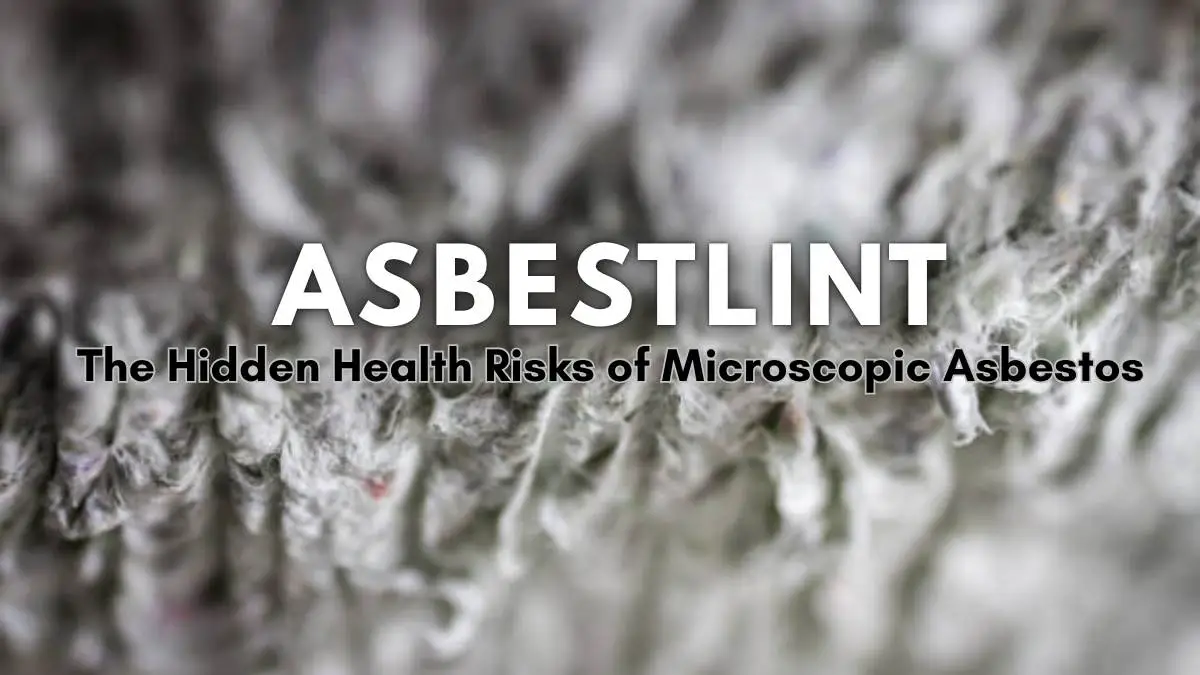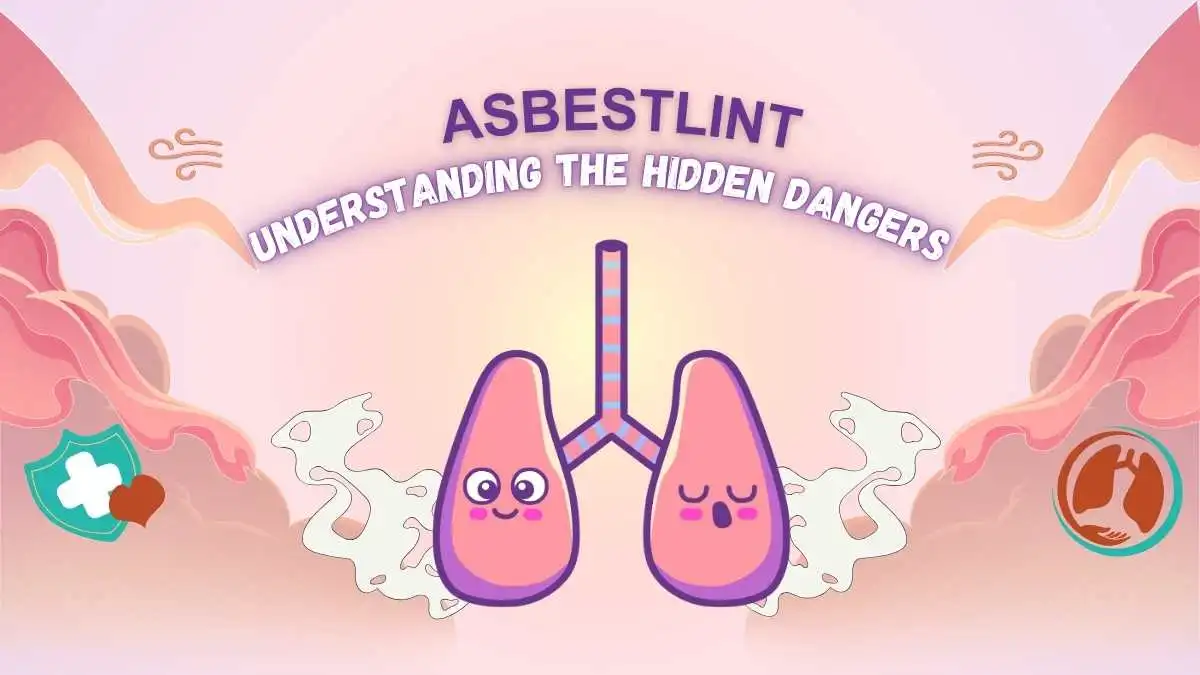HEALTH AND FITNESS
Asbestlint: The Hidden Health Risks of Microscopic Asbestos

Asbestlint is a term derived from combining “asbestos” and “lint,” and it refers to the fine, fluffy, dust-like material composed of microscopic asbestos fibers. While it may visually resemble textile lint, asbestlint is far from harmless. This airborne contaminant often becomes present during the disturbance, deterioration, or handling of materials containing asbestos, especially in older buildings, industrial sites, shipyards, and textile manufacturing facilities that once relied heavily on asbestos products.
Due to the needle-like structure of asbestos fibers, inhaling asbestlint can cause severe health problems over time, including asbestosis, lung cancer, and mesothelioma. The threat is not immediate or visible, which makes awareness and proper handling crucial.
The Composition and Formation of Asbestlint
Asbestlint is formed when asbestos-containing materials (ACMs) such as insulation, cement sheets, roofing, textiles, and gaskets are broken, aged, or improperly handled. As these materials degrade, they release friable asbestos fibers that can become airborne. These fibers then accumulate as a soft, lint-like material, often undetected in air ducts, crawlspaces, or behind walls.
Common activities that can lead to the formation of asbestos lint include:
- Renovation or demolition of older structures
- Improper removal or disturbance of ACMs
- Maintenance work in industrial facilities with legacy asbestos components
- Textile operations involving asbestos fabrics
Health Risks Associated with Asbestlint Exposure
Inhalation of asbestlint poses serious and irreversible health risks. Unlike other airborne dust, asbestos fibers are durable, sharp, and resistant to breakdown in the lungs. Once inhaled, these fibers can embed deep into the lung tissues and cause long-term inflammation and cellular damage. The major health conditions linked to asbestlint exposure include:
1. Asbestosis
A chronic lung condition characterized by scarring (fibrosis) of the lung tissue. It leads to shortness of breath, chronic cough, and reduced lung function.
2. Lung Cancer
Asbestos exposure significantly increases the risk of developing lung cancer, especially among smokers. The symptoms may take decades to appear, making early detection difficult.
3. Mesothelioma
A rare and aggressive cancer affecting the lining of the lungs, abdomen, or heart. Mesothelioma has a strong causal link with asbestos exposure and is often diagnosed in later stages, with limited treatment options.

Where is Asbestlint commonly found?
Asbestos lint is typically found in locations where asbestos was historically used, particularly before the 1980s when its use became more strictly regulated or banned in many countries. Common environments include:
- Old Construction Sites: Especially homes, schools, and industrial buildings built before 1985.
- Shipyards: Ships were widely insulated using asbestos materials.
- Textile Factories: Especially those that produced fireproof clothing, gloves, or blankets.
- Boiler Rooms and HVAC Systems: Where insulation and lagging materials may deteriorate.
- Abandoned Industrial Facilities: As these deteriorate over time, fibers can accumulate and spread.
Why Asbestlint Is More Dangerous Than It Appears
One of the most insidious aspects of asbestlint is that it doesn’t look harmful. It may resemble household lint or dust, leading to accidental exposure during cleaning or renovations. However, its microscopic fibers can float undetected in the air for hours, especially in poorly ventilated environments, increasing the risk of inhalation.
Unlike larger debris, these fibers are not caught by the body’s natural defenses (like nose hairs or mucus) and can penetrate deep into the alveoli, the smallest air sacs in the lungs.
Safety Protocols and Handling of Asbestlint
Due to the high toxicity of asbestos fibers, any suspected asbestlint contamination should never be handled by untrained individuals. The correct response includes:
1. Professional Inspection
Certified asbestos professionals can test air samples, identify contamination sources, and recommend remediation.
2. Controlled Removal (Abatement)
If removal is necessary, it must be conducted under strict containment procedures, including:
- Use of HEPA-filtered respirators and vacuums
- Full-body protective clothing
- Air filtration systems in enclosed work zones
3. Air Monitoring
Post-remediation, professionals perform air quality tests to ensure no residual asbestos remains.
4. Avoid DIY Disturbances
Never attempt to sand, cut, drill, or vacuum materials you suspect may contain asbestlint. Such actions can agitate and release fibers, creating an airborne hazard.
Regulatory Guidelines and Legal Aspects
Various countries have implemented strict regulations for asbestos handling to protect public health. For instance:
- OSHA (Occupational Safety and Health Administration) mandates specific exposure limits in the workplace.
- The EPA (Environmental Protection Agency) has guidelines for asbestos inspection and removal in residential and public buildings.
- The UK’s Control of Asbestos Regulations imposes legal duties for property owners and employers regarding asbestos risk management.
Failure to comply can result in legal penalties, fines, and serious health liabilities.
Recognizing the Signs of Asbestlint Exposure
Asbestolint-related diseases often have long latency periods, typically 10 to 40 years. However, early warning signs to watch for include:
- Persistent dry cough
- Chest pain or tightness
- Shortness of breath
- Unexplained weight loss
- Fatigue or clubbing of fingers
Anyone with a history of exposure, especially construction workers, shipyard workers, and maintenance staff in older buildings, should undergo regular health check-ups and lung function tests.
Preventive Measures for the Public
Even though the use of asbestos has been phased out in many regions, legacy materials continue to pose a threat. You can minimize risk by:
- Checking the construction date of your building
- Hiring licensed asbestos inspectors before renovations
- Never disturbing suspected ACMs without professional advice
- Using asbestos-safe cleaning techniques (e.g., damp wiping, HEPA vacuums)
FAQs
1. Can pets be affected by exposure to asbestlint?
Yes, pets can inhale asbestos fibers just like humans and may suffer from respiratory issues.
2. Does wearing a surgical mask protect against asbestlint exposure?
No, standard surgical masks do not provide adequate filtration against microscopic asbestos fibers.
3. Is asbestlint a risk during natural disasters like earthquakes or floods?
Yes, structural damage from natural disasters can disturb asbestos materials, releasing asbestlint into the air.
Conclusion: Stay Informed, Stay Safe
Asbestlint represents a silent but deadly health hazard. Unlike visible dust, its microscopic nature and lethal potential require heightened awareness and expert handling. With the resurgence of interest in renovating older homes and restoring industrial buildings, the risk of disturbing asbestos-containing materials has increased.
Understanding what asbestlint is, how it forms, and why it’s dangerous is vital for occupational safety, public health, and personal well-being. Whether you’re a homeowner, renovator, or contractor, knowing when and how to involve professionals can save lives.
-

 BIOGRAPHY7 months ago
BIOGRAPHY7 months agoBehind the Scenes with Sandra Orlow: An Exclusive Interview
-

 HOME1 year ago
HOME1 year agoDiscovering Insights: A Deep Dive into the //vital-mag.net blog
-

 HOME1 year ago
HOME1 year agoSifangds in Action: Real-Life Applications and Success Stories
-

 BIOGRAPHY1 year ago
BIOGRAPHY1 year agoThe Woman Behind the Comedian: Meet Andrew Santino Wife




























